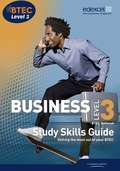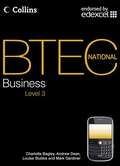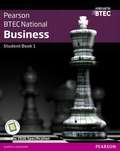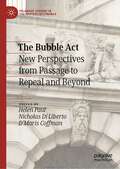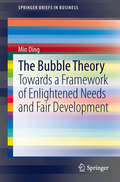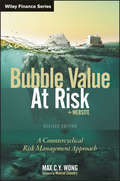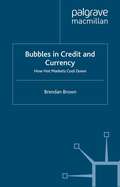- Table View
- List View
BTEC First in Travel and Tourism: student book (PDF)
by Andrew Kerr Tom Rock Malcolm Jefferies Christine King Rachael Aston Nicola Appleyard Gillian DaleResources designed to support learners of the new next generation BTEC First in Travel and Tourism specification*. Covers all core and mandatory units and a wide selection of optional units. (Units 1-10 in the Student Book and Units 11-13 on the Pearson Education website.) Each unit of the Student Book is presented in topics to ensure the content is accessible and engaging for learners. Covers of all the underpinning knowledge and understanding needed at level 2 to ensure that learners are fully prepared for this course. Activities in each unit provide support and clear direction for learners and can be used in the classroom or for independent work. New Assessment Zone guides learners through both internal and external assessment. Practice assignments and assessment guidance help learners to achieve their potential in internally assessed units. We can confirm that Units 11-13 are now available online to everyone who purchases the Student Book. * From 2012, Pearson Education's BTEC First qualifications have been under re-development, so schools and colleges could be teaching the existing 2010 specification or the new next generation 2012-2013 specification. There are different Student Books to support each specification. If learners are unsure, they should check with their teacher or tutor.
BTEC Level 2 First Business Student Book (PDF)
by Mike Neild Carol Carysforth Catherine RichardsThis student book covers the full BTEC Level 2 Business Diploma, including in-depth coverage of the four mandatory units and the 11 most popular units.
Btec Level 3 National Business Study Guide (PDF)
by John BevanYour study Skills Guide is designed to help you develop the skills you need to successfully complete your BTEC National course. It will help you to: * Understand the best way for you to learn * Cope with assessments * Manage your time * Get the most from your work experience * Work in a team * Use resources * Find, organise and interpret your information * Make a presentation * Get the most out of your BTEC With plenty of activities and case studies to improve your understanding, your Study Skills Guide will be a valuable companion as you work through the course. Includes: * A full sample assignment with advice on how you can improve your grade * Lots of easily-digestible tips and ideas to help you on your way * Write-in skills building section where you can practice essential personal, learning and thinking skills and functional skills
BTEC National Business: Book 1 (PDF)
by Naomi Birchall Naomi PillingCombine expert knowledge with case studies, clear explanations of business theory and key terms and support for vocational learning with this resource.
BTEC National Business — STUDENT TEXTBOOK
by Charlotte Bagley Andrew Dean Louise Stubbs Mark GardinerBtec Nationals Business Student Book 1 + Activebook: For The 2016 Specifications (PDF)
by Jenny Phillips Helen Coupland-Smith Catherine Richards Julie Smith Ann SummerscalesEach Student Book and ActiveBook has clearly laid out pages with a range of supportive features to aid learning and teaching: - Getting to know your unit sections ensure learners understand the grading criteria and unit requirements. - Getting ready for assessment sections focus on preparation for external assessment with guidance for learners on what to expect. Hints and tips will help them prepare for assessment and sample answers are provided for a range of question types including, short and long answer questions, all with a supporting commentary. - Pause point features provide opportunities for learners to self-evaluate their learning at regular intervals. Each Pause Point feature gives learners a Hint or Extend option to either revisit and reinforce the topic or encourage independent research or further study skills. - Case study and Theory into practice features enable development of problem-solving skills and place the theory into real-life situations learners could encounter. - Assessment practice features provide scaffolded assessment practice activities that help prepare learners for assessment. Within each assessment practice activity, a Plan, Do and Review section supports learners' formative assessment by making sure they fully understand what they are being asked to do, what their goals are and how to evaluate the task and consider how they could improve. - Dedicated Think future pages provide case studies from the industry, with a focus on aspects of skills development that can be put into practice in a real work environment and further study.
BTEC Nationals Business Student Book 1 + Activebook: For The 2016 Specifications (PDF)
by Jenny Phillips Helen Coupland-Smith Catherine Richards Julie Smith Ann SummerscalesUpdates to BTEC National Set Tasks for external assessment - April 2017 As a result of feedback from the Department for Education Pearson have made updates to the Set Tasks for some BTEC National qualifications. Therefore subsequent changes have been made to this product.
The Bubble Act: New Perspectives from Passage to Repeal and Beyond (Palgrave Studies in the History of Finance)
by Helen Paul Nicholas Di Liberto D’Maris CoffmanThis book reassesses the actual effects of the Bubble Act, still popularly associated with the bursting of the South Sea Bubble. The book builds on the foundational work of Ron Harris to discuss the act’s effect on corporate governance, literary culture, colonial law, and the Industrial Revolution. The Bubble Act was deemed an empty letter within England itself as it was rarely used in legal proceedings. Several chapters consider whether this was the case outside England, from Scotland to the Americas, India, and Africa. Others assess the impact of the act, both on literary culture and in the history of economic thought. The act has been conceptualized as a brake on economic development or of little consequence. This edited collection offers a timely reassessment of the Bubble Act and its legacy.
The Bubble Theory: Towards a Framework of Enlightened Needs and Fair Development (SpringerBriefs in Business)
by Min DingThe term sustainable development (SD) has now become a ubiquitous idea, philosophy, and guiding principle in our society. Governments, business, NGOs and individuals have embraced the mindset, and even the education institutions talk about graduating young people with sustainability in their DNA. Despite its noble origin, however, sustainable development is a concept that embodies compromise. This compromise has led to a term that is devoid of scientific foundation and actionable guidelines. In this volume, Min Ding offers an alternative to SD, introducing a framework, which he calls the Bubble Theory, built on three layers: the symbiotic duo (subconscious desires at the self and species levels); enlightened needs (manifested desires of the self and species beyond basic survival and procreation), and human development principles (with fair development as the ideal principle for the present). These fundamental concepts of enlightened needs (EN) and fair development (FD) have profound implications for both the theory and application of new practices in business and policymaking.
Bubble Value at Risk: A Countercyclical Risk Management Approach (Wiley Finance #848)
by Max C. WongIntroduces a powerful new approach to financial risk modeling with proven strategies for its real-world applications The 2008 credit crisis did much to debunk the much touted powers of Value at Risk (VaR) as a risk metric. Unlike most authors on VaR who focus on what it can do, in this book the author looks at what it cannot. In clear, accessible prose, finance practitioners, Max Wong, describes the VaR measure and what it was meant to do, then explores its various failures in the real world of crisis risk management. More importantly, he lays out a revolutionary new method of measuring risks, Bubble Value at Risk, that is countercyclical and offers a well-tested buffer against market crashes. Describes Bubble VaR, a more macro-prudential risk measure proven to avoid the limitations of VaR and by providing a more accurate risk exposure estimation over market cycles Makes a strong case that analysts and risk managers need to unlearn our existing "science" of risk measurement and discover more robust approaches to calculating risk capital Illustrates every key concept or formula with an abundance of practical, numerical examples, most of them provided in interactive Excel spreadsheets Features numerous real-world applications, throughout, based on the author’s firsthand experience as a veteran financial risk analyst
Bubble Value at Risk: A Countercyclical Risk Management Approach (Wiley Finance #848)
by Max C. WongIntroduces a powerful new approach to financial risk modeling with proven strategies for its real-world applications The 2008 credit crisis did much to debunk the much touted powers of Value at Risk (VaR) as a risk metric. Unlike most authors on VaR who focus on what it can do, in this book the author looks at what it cannot. In clear, accessible prose, finance practitioners, Max Wong, describes the VaR measure and what it was meant to do, then explores its various failures in the real world of crisis risk management. More importantly, he lays out a revolutionary new method of measuring risks, Bubble Value at Risk, that is countercyclical and offers a well-tested buffer against market crashes. Describes Bubble VaR, a more macro-prudential risk measure proven to avoid the limitations of VaR and by providing a more accurate risk exposure estimation over market cycles Makes a strong case that analysts and risk managers need to unlearn our existing "science" of risk measurement and discover more robust approaches to calculating risk capital Illustrates every key concept or formula with an abundance of practical, numerical examples, most of them provided in interactive Excel spreadsheets Features numerous real-world applications, throughout, based on the author’s firsthand experience as a veteran financial risk analyst
Bubbles and Contagion in Financial Markets, Volume 1: An Integrative View
by E. PorrasUnderstanding the formation of bubbles and the contagion mechanisms afflicting financial markets is a must as extreme volatility events leave no market untouched. Debt, equity, real estate, commodities… Shanghai, NY, or London: The severe fluctuations, explained to a large extent by contagion and the fear of new bubbles imploding, justify the newly awaken interest in the contagion and bubble dynamics as yet again the world brazes for a new global economic upheaval.Bubbles and Contagion in Financial Markets explores concepts, intuition, theory, and models. Fundamental valuation, share price development in the presence of asymmetric information, the speculative behavior of noise traders and chartists, herding and the feedback and learning mechanisms that surge within the markets are key aspects of these dynamics. Bubbles and contagion are a vast world and fascinating phenomena that escape a narrow exploration of financial markets. Hence this work looks beyond into macroeconomics, monetary policy, risk aggregation, psychology, incentive structures and many more subjects which are in part co-responsible for these events. Responding to the ever more pressing need to disentangle the dynamics by which financial local events are transmitted across the globe, this volume presents an exhaustive and integrative outlook to the subject of bubbles and contagion in financial markets. The key objective of this volume is to give the reader a comprehensive understanding of all aspects that can potentially create the conditions for the formation and bursting of bubbles, and the aftermath of such events: the contagion of macro-economic processes. Achieving a better understanding of the formation of bubbles and the impact of contagion will no doubt determine the stability of future economies – let these two volumes be the starting point for a rational approach to a seemingly irrational phenomena.
Bubbles and Contagion in Financial Markets, Volume 2: Models and Mathematics
by Eva R. PorrasThis book focuses on extending the models and theories (from a mathematical/statistical point of view) which were introduced in the first volume to a more technical level. Where volume I provided an introduction to the mathematics of bubbles and contagion, volume II digs far more deeply and widely into the modeling aspects.
Bubbles and Crashes: The Boom and Bust of Technological Innovation
by David A. Kirsch Brent GoldfarbFinancial market bubbles are recurring, often painful, reminders of the costs and benefits of capitalism. While many books have studied financial manias and crises, most fail to compare times of turmoil with times of stability. In Bubbles and Crashes, Brent Goldfarb and David A. Kirsch give us new insights into the causes of speculative booms and busts. They identify a class of assets—major technological innovations—that can, but does not necessarily, produce bubbles. This methodological twist is essential: Only by comparing similar events that sometimes lead to booms and busts can we ascertain the root causes of bubbles. Using a sample of eighty-eight technologies spanning 150 years, Goldfarb and Kirsch find that four factors play a key role in these episodes: the degree of uncertainty surrounding a particular innovation, the attentive presence of novice investors, the opportunity to directly invest in companies that specialize in the technology, and whether or not a technology is a good protagonist in a narrative. Goldfarb and Kirsch consider the implications of their analysis for technology bubbles that may be in the works today, offer tools for investors to identify whether a bubble is happening, and propose policy measures that may mitigate the risks associated with future speculative episodes.
Bubbles and Crashes in Experimental Asset Markets (Lecture Notes in Economics and Mathematical Systems #626)
by Stefan PalanThis book describes a laboratory experiment designed to test the causes and properties of bubbles in financial markets and explores the question whether it is possible to design markets which avoid such bubbles and crashes. In the experiment, subjects were given the opportunity to trade in a stock market modeled after the seminal work of Smith et al. (1988). To account for the increasing importance of online betting sites, subjects were also allowed to trade in a digital option market. The outcomes shed new light on how subjects form and update their expectations, placing special emphasis on the bounded rationality of investors. Various analytical bubble measures found in the literature are collected, calculated, classified and presented for the first time. The very interesting new bubble measures "Dispersion Ratio", "Overpriced Transactions" and "Underpriced Transactions" are developed, making the book an important step towards the research goal of preventing bubbles and crashes in financial markets.
Bubbles, Booms, and Busts: The Rise and Fall of Financial Assets
by Donald RappThis book deals at some length with the question: Since there are many more poor than rich, why don’t the poor just tax the rich heavily and reduce the inequality? In the 19th century and the first half of the 20th century, the topic of inequality was discussed widely. Ending or reducing inequality was a prime motivating factor in the emergence of communism and socialism. The book discusses why later in the 20th century, inequality has faded out as an issue. Extensive tables and graphs of data are presented showing the extent of inequality in America, as well as globally. It is shown that a combination of low taxes on capital gains contributed to a series of real estate and stock bubbles that provided great wealth to the top tiers, while real income for average workers stagnated. Improved commercial efficiency due to computers, electronics, the Internet and fast transport allowed production and distribution with fewer workers, just as the advent of electrification, mechanization, production lines, vehicles and trains in the 1920s and 1930s produced the same stagnating effect.
Bubbles, Booms, and Busts: The Rise and Fall of Financial Assets
by Donald RappThis book provides a thorough explanation of the nature and history of booms, bubbles and busts in financial markets. The first part of the book deals with financial booms and bubbles and how they emerge, develop and collapse. It describes the distribution of wealth, inflation, rationality of bankers, monetary and fiscal policy, the role of central banks, tax policies, social security, US federal, state, municipal and personal debt, and valuation of common stocks. The book describes historical boom/bust cycles including bubbles of the 1720s, the Florida land boom and the stock market in the 1920s, the depression of the 1930s, the S&L scandal of the 1980s, the great bull market of 1982-1995, the crash of 1987, the dot.com mania of 1995-2000, corporate swindles of the 1990s and 2000s, the sub-prime fiasco of the 2000s, and Japan in the late 20th century. Most of the recent wealth generation has derived from increased debt and appreciation of paper assets. The architects of the new economics were Ronald Reagan and Arthur Greenspan. Inevitably, the US Government’s cure for excessive spending and inadequate revenues is to increase spending and cut revenues. American voters must choose between “tax and spend” Democrats and “spend and borrow” Republicans. The theme of American finance was uttered by VP Cheney: “Deficits don’t matter”.
Bubbles in Credit and Currency: How Hot Markets Cool Down
by B. BrownDrawing on behavioral finance theory and contemporary experience, this book explores how bubbles form and subsequently burst. The author introduces a new concept of swings in market temperature defined by the extent of heterogeneity of opinion and soft irrationality, and examines the importance of these swings in the credit markets.
Bubbles und Excess Volatility auf dem deutschen Aktienmarkt
by Christoph BrunsDas Buch untersucht die Phänomene Bubbles und Excess Volatility und geht insbesondere der Frage nach, ob beide auch auf dem deutschen Aktienmarkt nachweisbar sind. Der hierbei verwendete Datensatz reicht bis in das Jahr 1994 hinein.
Buch Berühmter Kaufleute: Männer von Tatkraft und Unternehmungsgeist in ihrem Lebensgange geschildert
by Wilhelm BerdrowBuchführung: Einführung in die Finanzbuchaltung auf der Grundlage von Einnahmen und Ausgaben
by Hans Fritz Groß Achim NettelmannBuchführung: Grundlagen - Übungen - Klausurvorbereitung. Mit Lern- und Übungs-CD-ROM
by Jörn Littkemann Michael Holtrup Klaus SchulteDieses grundlegende Lehrbuch zur Buchführung ist primär als Übungsbuch konzipiert. Es vermittelt zu jedem Kapitel zunächst kompakt und prägnant die formalen und inhaltlichen Grundlagen des Faches. Anhand zahlreicher Aufgaben und Lösungen wird der Stoff übersichtlich illustriert. Durch eine themenübergreifende Modellierung von Übungsklausuren mit Musterlösungen wird ein vertiefender Einblick in die Materie gewährt, der die Studierenden bei einer effektiven Prüfungs- und Klausurvorbereitung unterstützt. Die Aufgaben und Lösungen können anhand einer Excel-basierten Lern- und Übungs-CD im Selbststudium nachvollzogen werden. Insbesondere das eigenständige Erarbeiten der Lösungen fördert die routinierte Anwendung des Buchungswissens. Die zweite Auflage berücksichtigt die aktuelle Gesetzeslage. Neben dem aktuellen Mehrwertsteuersatz sind ebenso die derzeitigen Beitragssätze zur gesetzlichen Sozialversicherung enthalten. Zudem werden wieder aktuelle Klausuren für ein gezieltes Prüfungstraining angeboten.
Buchführung: Einführung in die gesetzlichen Vorschriften und in die Buchführungstechnik
by Karin NickenigDieses Lehrbuch bietet Ihnen anhand eines durchgehenden Praxisbeispiels einen leichten Einstieg in die gesetzlichen Grundlagen der Buchführungspflicht und die komplexe Welt der Buchungssätze. Praxisrelevante Hinweise (z. B. auf die GoBD), Kontrollfragen und Übungsaufgaben mit Lösungswegen zu jedem Thema befähigen Sie schnell, die vermeintlichen Geheimnisse der Buchführung zu verstehen, sich das relevante Praxis- oder Prüfungswissen anzueignen, eine einfache Buchführung selbst zu erstellen und das Fachvokabular von Buchhaltern und Steuerberatern souverän einzusetzen. Die Einführung eignet sich besonders gut für berufliche Neu- und Wiedereinsteiger, Gewerbetreibende, Freiberufler und Existenzgründer sowie für Bachelor-Studierende und Auszubildende in kaufmännischen und steuerrelevanten Berufen. Die vorliegende zweite Auflage wurde gründlich durchgesehen und verbessert.
Buchführung: Einführung in die gesetzlichen Vorschriften und in die Buchführungstechnik
by Karin NickenigDieses Lehrbuch bietet Ihnen anhand eines durchgehenden Praxisbeispiels einen leichten Einstieg in die gesetzlichen Grundlagen der Buchführungspflicht und die komplexe Welt der Buchungssätze. Praxisrelevante Hinweise (z. B. auf die GoBD), Kontrollfragen und Übungsaufgaben mit Lösungswegen zu jedem Thema befähigen Sie schnell, die vermeintlichen Geheimnisse der Buchführung zu verstehen, sich das relevante Praxis- oder Prüfungswissen anzueignen, eine einfache Buchführung selbst zu erstellen und das Fachvokabular von Buchhaltern und Steuerberatern souverän einzusetzen. Die Einführung eignet sich besonders gut für berufliche Neu- und Wiedereinsteiger, Gewerbetreibende, Freiberufler und Existenzgründer sowie für Bachelor-Studierende und Auszubildende in kaufmännischen und steuerrelevanten Berufen.
Buchführung: Einführung in die gesetzlichen Vorschriften und in die Buchführungstechnik
by Karin NickenigDieses Lehrbuch bietet Ihnen anhand eines durchgehenden Praxisbeispiels einen leichten Einstieg in die gesetzlichen Grundlagen der Buchführungspflicht und die komplexe Welt der Buchungssätze. Praxisrelevante Hinweise (z. B. auf die GoBD), Kontrollfragen und Übungsaufgaben mit Lösungswegen zu jedem Thema befähigen Sie schnell, die vermeintlichen Geheimnisse der Buchführung zu verstehen, sich das relevante Praxis- oder Prüfungswissen anzueignen, eine einfache Buchführung selbst zu erstellen und das Fachvokabular von Buchhaltern und Steuerberatern souverän einzusetzen. Die Einführung eignet sich besonders gut für berufliche Neu- und Wiedereinsteiger, Gewerbetreibende, Freiberufler und Existenzgründer sowie für Bachelor-Studierende und Auszubildende in kaufmännischen und steuerrelevanten Berufen. Die aktualisierte 3. Auflage wurde optimiert und auf die Rechtslage Sommer 2019 gebracht.


